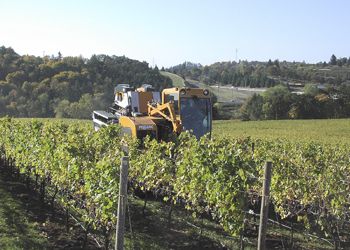#7 STORY of 2010: Eastsider Automates

First Published in the October 2010 Edition
By Dana Tims
Maybe Oregon’s Pinot Noir pioneers had it right after all, that the rolling hillsides near Silverton — not Dundee — were best suited to cradle the state’s wine industry.
Ken Johnston, general manager of vineyard operations for Winemakers Investment Properties, certainly thinks so, and he’s in the middle of a multimillion-dollar venture to prove it, using a mechanical-based business model all but unheard of elsewhere in the Willamette Valley.
At a time when recessionary pressures on the state’s $1 billion wine industry are threatening to leave tons of grapes unpicked this year, Johnston is developing more than 550 acres of vineyards west of Silverton — huge by Oregon’s traditional mom-and-pop standards. His business model relies on efficiency of scale to help keep long-term costs and consumer prices down.
Industry insiders are impressed.
“It’s absolutely a game-changer,” said Joseph Wagner, whose family founded Napa Valley’s Caymus Vineyards, which has relied largely on mechanical harvesting for the past five years. Not only has the method worked, he said, but it has actually increased the quality of the fruit at harvest.
There is no way, he said, to underestimate its potential for Oregon’s wine operations.
“It’s going to maintain quality, guarantee a complete harvest and cut costs by anywhere from 15 to 30 percent,” Wagner said. “All in all, a can’t-miss proposition.”
By the time Johnston’s vines are producing — one of the two eastside vineyards will produce fruit this year; the other, next — his company will be either first or second in the Willamette Valley in terms of total vineyard acreage. And it’s not lost on Johnston that almost all of that property lies well outside the acclaimed vineyards of Yamhill County.
“There is an industry-wide perception that the east side of the valley doesn’t grow as good a quality of wine grapes as the west side,” Johnston said. “I think we’re going to change all that.”
As a would-be agent of viticultural change, he has plenty of company. The ranks of new vineyards, new wineries and reinvigorated older properties on the valley’s long-neglected east side continue to swell.
Kraemer Farms of Mount Angel, for instance, has long been associated with caneberries and various row crops. More recent ventures into wine grapes now cover nearly 500 acres.
Silverton’s Vitis Ridge added 100 acres of vines between 2006 and 2008, said Chris Deckelmann, a partner in the operation. He was so pleased with the fruit that he added an additional 18 acres east of town last year, bringing his total close to 200 acres.
And at AlexEli Vineyard & Winery near Molalla, Phil Kramer is breathing new life into the formerly named Marquam Hill Vineyards, first planted in 1983. A rebuilt tasting room, live jazz on a new patio overlooking Mount Hood and even fishing rights to a trout-stocked pond on the property have already attracted more visitors so far this year than in all of 2009.
In all, more than a dozen wineries, aptly named the “East Siders,” now populate Marion County hillsides once exclusively draped in Christmas trees, nursery stock, all sorts of berries and numerous grasses.
“We’re far enough away from Yamhill County that it’s hard for us to wave our arms over here and be heard on that side of the valley,” said Pete Buffington, owner of Abiqua Wind Vineyard, tucked into the hills above Scotts Mills. “But some impressive things are happening here.”
The most significant, by far, is the effort Johnston is spearheading outside Silverton. On completion, the two vineyards now under development will total 567 acres, 300 acres of which will contain vines. Typical estate vineyards on the valley’s west side, by contrast, are less than 40 acres.
Long rows, up to 1,000 feet, bring a practicality to mechanized harvest that the west side can’t match.
The decision to go mechanical also addresses looming labor shortages. Immigration bills in play in both Arizona and Florida could, if introduced in Oregon or even nationally, severely limit access to migrant labor considered crucial for all hand-harvesting operations.
Robert Nicholson, a principal with International Wine Associates in Healdsburg, Calif., agreed, noting that mechanical harvesting already is well accepted in wine regions worldwide, including France’s Burgundy region, considered the home of Pinot Noir.
“If you improve efficiencies in Oregon from an economic standpoint, you’ll deliver more competitive wines that will sell to a broader group of people,” Nicholson said. “As things stand now, most of Oregon’s high-end Pinot Noir sells to a fairly esoteric group of consumers.”
Johnston hopes all of that translates to a retail price point of between $15 and $20 per bottle, substantially less than the $30 and up asked by many westside wineries.
“There’s no reason that what we’re doing here can’t be emulated elsewhere in the valley,” he said. “It really feels like a winning formula.”
He would likely get agreement from at least two Oregon Pinot pioneers — Dick Erath and the late David Lett, the first vintners to plant Pinot Noir in the northern Willamette Valley in the late 1960s.
A widely accepted story — partially disputed by Lett’s son, Jason — holds that Lett’s own soil studies convinced him that the rolling, verdant hills ringing Silverton held the promise of growing great grapes in Oregon. However, prohibitively high land prices forced him to look elsewhere. His search eventually took him to the hills above Dundee, where he founded The Eyrie Vineyards.
Similarly, Erath’s first vineyard-designated Pinot Noir came from a vineyard near Oregon City, said Kevin Chambers, owner of Oregon Vineyard Supply in McMinnville.
“Most people don’t know that,” Chambers added. “But it was really extraordinary wine.”
In Johnston’s case, he’s hoping that the promise of the past portends a successful future.
“This part of the valley simply hasn’t had enough grapes coming off of it to garner the reputation we think it deserves,” he said. “We have every intention of proving it out.”
Dana Tims is a writer for The Oregonian. Story available through AP Member Exchange.












